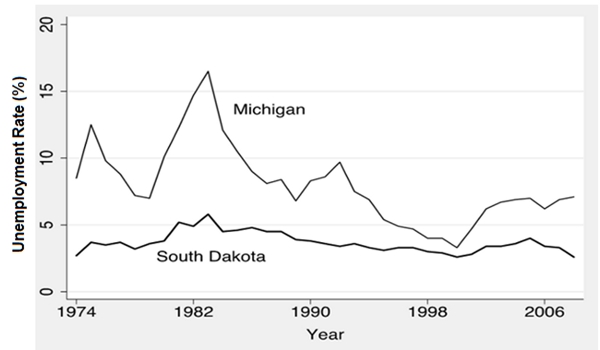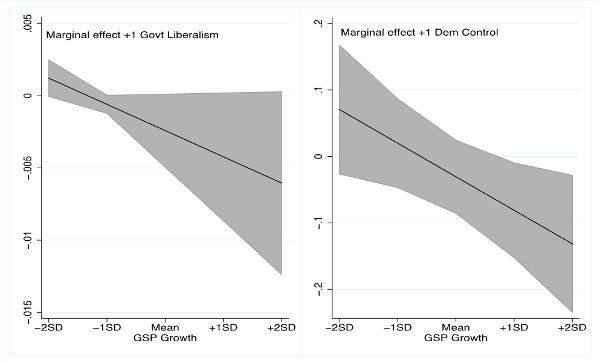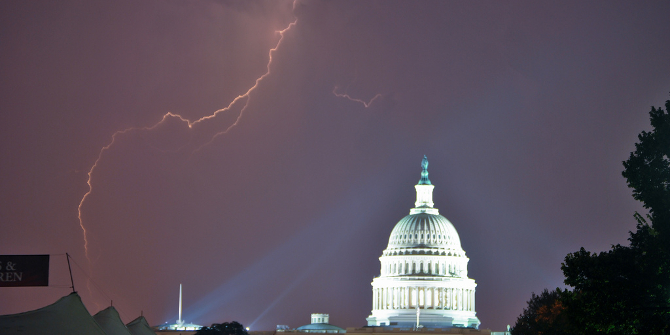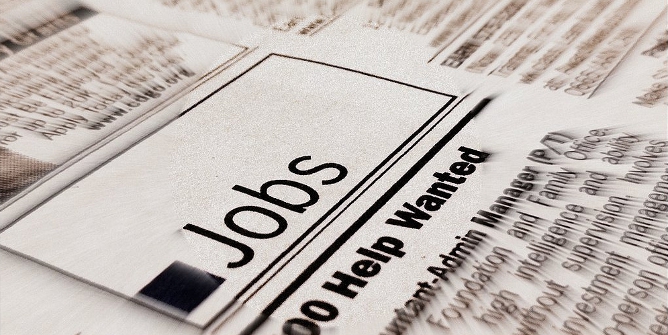
 In the years following the Great Recession, unemployment rates have varied markedly across U.S. states. While much of this is down to national trends, how do state politics influence unemployment levels? In new research, Christopher Witko and Nate Kelly find that while in recessions, both Republican and Democratic governments have little effect on unemployment rates, during times of increasing growth, states with Democratic governments see larger reductions in unemployment. They argue that liberal governments have more freedom to introduce policies that stimulate employment such as consumption spending when growth is on the rise.
In the years following the Great Recession, unemployment rates have varied markedly across U.S. states. While much of this is down to national trends, how do state politics influence unemployment levels? In new research, Christopher Witko and Nate Kelly find that while in recessions, both Republican and Democratic governments have little effect on unemployment rates, during times of increasing growth, states with Democratic governments see larger reductions in unemployment. They argue that liberal governments have more freedom to introduce policies that stimulate employment such as consumption spending when growth is on the rise.
In the aftermath of the most recent national recession, state unemployment rates vary dramatically, ranging from just over 2.8 percent (South Dakota) to nearly 8 percent (Georgia) in late 2014. Historically, there has been substantial variation among the states in terms of levels and variability in unemployment. Figure 1 below shows the differences in both mean and variation in two states, Michigan and South Dakota. While there are clearly common responses to national economic trends, there is also a large state-specific element. While a variety of socio-economic factors influence this variation, we ask, does state politics influence this variation? In new research, we find that while states have a limited ability to act to reduce unemployment during recessions, during times of moderate to high growth, states with left leaning governments tend to have more significant reductions in unemployment.
Figure 1 – Unemployment rate in Michigan and South Dakota, 1974 – 2010

Across affluent nations left wing governments are associated with lower unemployment, and national-level research in the U.S. shows that Democratic control of government is also associated with lower unemployment. But whether this association between left-leaning party governments and unemployment exists in the states has been largely neglected.
Theoretically, as with their national counterparts it makes sense that more left leaning state governments are more concerned with and willing to use the government to reduce unemployment, since recent research shows that liberal state governments are associated with economic policies and outcomes beneficial for those with lower incomes. However, while the states do have authority over a large number of policies that may influence unemployment, they also face constraints on their use of public policy to shape employment outcomes, and these constraints are most severe during economic downturns. Most notably, due to balanced budget requirements, states cannot easily use fiscal policy to spur employment during economic downturns because they would need to raise taxes to boost spending, and raising taxes could offset any benefits of increased expenditures. But regulatory policies – such as requiring additional workers at hospitals or day care centers are also probably less likely to be enacted during economic downturns when governments are most sensitive to increased costs imposed on business. Taken together then, we anticipate that liberal governments will be dependent on economic growth cycles to reduce unemployment.
To test this theory, we examined the effect of government liberalism and Democratic Party control of government on changes in state unemployment rates between 1976 and 2010, allowing the effect of these variables to vary across different rates of economic growth with interaction terms. We limit our analysis of state party control to non-Southern states where the Democratic Party was consistently the more liberal alternative during the entire time period of our study. We control for the “usual suspects” found in the literature.
The effect of state government liberalism (using the measure from Berry et al. 2012) and party control of government (using Carl Klarner’s party data, with 1 point each for control of the state upper legislative chamber, lower legislative chamber, and governorship) across different rates of growth in gross state product is shown in Figure 2 below.
Figure 2 – Effect of state government liberalism and party control of government across growth in Gross State Product (GSP)

We see that when economic growth is slow, increases in unemployment rates in liberal states are similar to or even higher than increases in conservative states (though the effects are not distinguishable from zero). But as growth increases to moderate to high levels, left-leaning state governments are associated with more rapid reductions in unemployment. To put these effects into more meaningful terms, when economic growth is one standard deviation higher than average a one standard deviation increase in liberalism would result in an approximately 0.2 percentage point reduction in the unemployment rate. For party control, the total effect of a one- unit increase (i.e. one additional Democratic institution) at plus one standard deviations of economic growth would be approximately -0.35. Thus, these effects are fairly substantively large.
While more research needs to be done to understand what is driving these relationships, we suggest that fiscal policy choices and constraints may be an important factor creating these pro-cyclical effects of state government liberalism on unemployment. During recessions governments must make trade-offs between investment and consumption spending and liberal state governments prefer consumption over investment spending in such situations, which may create a net drag on job growth during economic downturns when it cannot easily be offset by other policies that spur employment. In contrast, during periods of growth additional consumption spending that does not come at the expense of investment spending or require tax increases may be net stimulative, and liberal governments have more freedom to enact other types of policies that stimulate employment during periods of rapid economic growth.
Despite the policymaking constraints that they face, our research shows that the states play an important, albeit complex, role in the political economy of employment. As the dysfunction and gridlock in Washington, D.C. continue unabated, states have taken the lead in trying to tackle growing problems like income inequality, poverty and unemployment, and our study adds to research indicating that these state activities matter. Regarding employment, however, unlike national governments, left-leaning state governments appear very dependent on economic growth cycles to produce lower unemployment. Unfortunately then, states that would like to act to reduce unemployment have a very limited ability to do so during major recessions when the need for government to stimulate employment is greatest. While the states have powerful tools to shape important economic outcomes, they also face many more limitations than a well-functioning federal government. On the other hand, it seems clear that as the economy continues to recover states will have more discretion to influence employment outcomes should they choose to do so.
This article is based on the paper, ‘Government Ideology and Unemployment in the U.S. States’ in State Politics & Policy.
Featured image credit: photologue_np (Flickr, CC-BY-2.0)
Please read our comments policy before commenting.
Note: This article gives the views of the author, and not the position of USApp– American Politics and Policy, nor of the London School of Economics.
Shortened URL for this post: http://bit.ly/1qxVhX1
_________________________________
 Christopher Witko – University of South Carolina
Christopher Witko – University of South Carolina
Dr. Christopher Witko is an Associate Professor of Political Science and Director of the Masters of Public Administration program at the University of South Carolina. His teaching and research focuses on American politics and public policy.
_
 Nathan J. Kelly – University of Tennessee
Nathan J. Kelly – University of Tennessee
Nathan J. Kelly, an assistant professor of political science at the University of Tennessee in 2005. His primary research program examines how macro political dynamics influence, and are influenced by, income inequality in the United States. Within this research agenda, he continues to conduct research on how income inequality influences public opinion and the democratic system more broadly.






